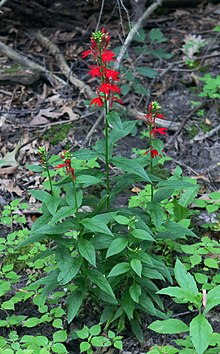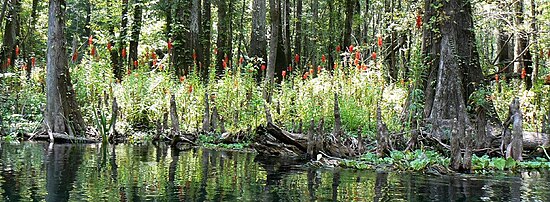Lobelia cardinalis
| Lobelia cardinalis | |
|---|---|

| |
| Scientific classification | |
| Kingdom: | Plantae |
| Clade: | Tracheophytes |
| Clade: | Angiosperms |
| Clade: | Eudicots |
| Clade: | Asterids |
| Order: | Asterales |
| Family: | Campanulaceae |
| Genus: | Lobelia |
| Species: | L. cardinalis
|
| Binomial name | |
| Lobelia cardinalis | |
| Synonyms[3] | |
|
List
| |
Lobelia cardinalis, the cardinal flower (syn. L. fulgens), is a species of flowering plant in the bellflower family Campanulaceae native to the Americas, from southeastern Canada south through the eastern and southwestern United States, Mexico and Central America to northern Colombia.[4]
Description and habitat
[edit]Lobelia cardinalis is a perennial herbaceous plant which grows up to 1.2 m (4 ft) tall. It is found primarily in wet places, such as riparian zones, riverbanks, bogs or swamps. It is also sometimes found in damp or semi-flooded and shaded forest areas.[5] The plant tends to occupy locations near a water source, providing its roots with consistent hydration via groundwater from the saturated soil. It may be found growing slightly away from or closer to the water, and may even be found growing aquatically, with some or all of the plant submerged and its flowers rising from the surface.[5]
The leaves are up to 20 cm (8 in) long and 5 cm (2 in) broad, lanceolate to oval, featuring a toothed margin. The flowers are usually vibrant red, have five deep lobes, and are up to 4 cm across; they are produced via an erect raceme, up to 70 cm (28 in) tall, during the summer and into the fall. Some forms with white (f. alba) and pink (f. rosea) flowers are also known.[6]

L. cardinalis is related to two other Lobelia species found in the Eastern United States, Lobelia inflata ('Indian tobacco') and Lobelia siphilitica ('great lobelia'). As is typical of the genus, all display the characteristic "lip" petal near the opening of the flower and a "milky" secretion when the plant is broken. L. siphilitica has blue flowers and is primarily pollinated by bees, whereas L. cardinalis is red, and is primarily pollinated by the ruby-throated hummingbird (Archilochus colubris).[7]

Etymology
[edit]Lobelia cardinalis was first introduced to Europe in the mid-1620s; the name 'cardinal flower' was in use by 1629, likely due to the similarity of the flower's color to the vesture of Roman Catholic Cardinals.[8]
Growing and cultivars
[edit]In cultivation, L. cardinalis requires rich, fairly deep soil which remains reliably moist—yet sufficiently aerated—all year-round; alternatively, it may be grown as an accent plant in or along ponds, fountains or other garden water features, with its pot positioned so it can always access water. If not planted in or around a water source, L. cardinalis tends to prefer for its roots to stay cool, something achieved when grown in dappled sun or part shade.[9] The cultivar 'Queen Victoria' has gained the Royal Horticultural Society's Award of Garden Merit.[10][11]
This plant is easily propagated by seed or by dividing-out the young plants, which are seen forming around the older, more mature plants each year. Although the plant is generally considered a perennial, they may be short-lived, or behave more as a "long-term annual".
Within the freshwater planted aquarium and aquascaping hobbies, the species is used somewhat frequently.[12] At least one new variety has been developed and is available commercially, Lobelia cardinalis 'Mini', with small and compact green leaves.[13][14]
Medicinal and other uses
[edit]The Zuni people use this plant as an ingredient of "schumaakwe cakes" and used it externally for rheumatism and swelling.[15] The Penobscot people smoked the dried leaves as a substitute for tobacco. It may also have been chewed.[16]
Toxicity
[edit]As a member of the Lobelia genus, L. cardinalis contains a number of naturally-occurring, toxic alkaloids, including lobelanine and lobeline,[17] thus rendering the species potentially harmful if ingested.[18] Various negative physical symptoms may manifest upon consuming even small or mid-sized quantities of the plant, including nausea, vomiting, diarrhea, excessive salivation, fatigue/exhaustion, weakness, dilation of pupils, convulsions, and even coma.[17]
References
[edit]- ^ Maiz-Tome, L. (2016). "Lobelia cardinalis". IUCN Red List of Threatened Species. 2016: e.T64317175A67729977. doi:10.2305/IUCN.UK.2016-1.RLTS.T64317175A67729977.en. Retrieved 23 July 2023.
- ^ NatureServe (2024). "Lobelia cardinalis". Arlington, Virginia. Retrieved 11 January 2024.
- ^ "Lobelia cardinalis L." Plants of the World Online. Board of Trustees of the Royal Botanic Gardens, Kew. 2017. Retrieved 2 December 2020.
- ^ "Lobelia cardinalis". Germplasm Resources Information Network. Agricultural Research Service, United States Department of Agriculture. Retrieved 21 December 2017.
- ^ a b "Lobelia cardinalis - Plant Finder". www.missouribotanicalgarden.org. Retrieved 2022-01-18.
- ^ Missouriplants: Lobelia cardinalis Archived 2007-10-11 at the Wayback Machine
- ^ Caruso, C. M.; Peterson, S. B.; Ridley, C. E. (2003), "Natural selection on floral traits of Lobelia (Lobeliaceae): spatial and temporal variation", American Journal of Botany, 90 (9): 1333–40, doi:10.3732/ajb.90.9.1333, PMID 21659233
- ^ Donaldson, C. (1999). Cardinal Flower – Spectacular Scarlet Blossoms That Hummingbirds Adore Archived 2009-02-16 at the Wayback Machine. Plants & Gardens News 14 (3). online at Brooklyn Botanic Garden. Accessed 23 May 2006.
- ^ Frances Tenenbaum (2003). Taylor's Encyclopedia of Garden Plants. Houghton Mifflin Harcourt. pp. 244–. ISBN 0-618-22644-3.
- ^ "RHS Plant Selector - Lobelia cardinalis 'Queen Victoria'". Retrieved 2 October 2020.
- ^ "AGM Plants - Ornamental" (PDF). Royal Horticultural Society. July 2017. p. 61. Retrieved 25 March 2018.
- ^ "Lobelia cardinalis". Tropica Aquarium Plants (official website). Retrieved 12 May 2024.
In the nursery this plant is cultivated in marshy conditions, forming dark-green leaves which are purple underneath. In aquariums the leaves turn a beautiful shade of light-green, with stems 10-30 cm tall and 5-10 cm wide. Widely used in Dutch aquariums in so-called "plant streets". In open aquariums it grows above the water surface, where it forms very beautiful scarlet flowers and the leaves regain their colour. Can be used in garden ponds.
- ^ "Lobelia collections Aquarium Plants Factory APF". www.AquariumPlantsFactory.com. Retrieved 12 May 2024.
- ^ "Lobelia cardinalis 'Mini'". Www.TropicaAquariumPlants.com. Retrieved 12 May 2024.
- ^ Stevenson, Matilda Coxe 1915 Ethnobotany of the Zuni Indians. SI-BAE Annual Report #30 (p. 56)
- ^ Guédon, Marie-Françoise. Sacred Smudging in North America, Walkabout Press 2000
- ^ a b "Lobelia cardinalis". North Carolina State University Extension.
- ^ Foster, Steven and James A. Duke. Eastern/Central Medicinal Plants. Peterson Field Guides, Houghton, Mifflin 1990 edn. ISBN 0-395-92066-3


